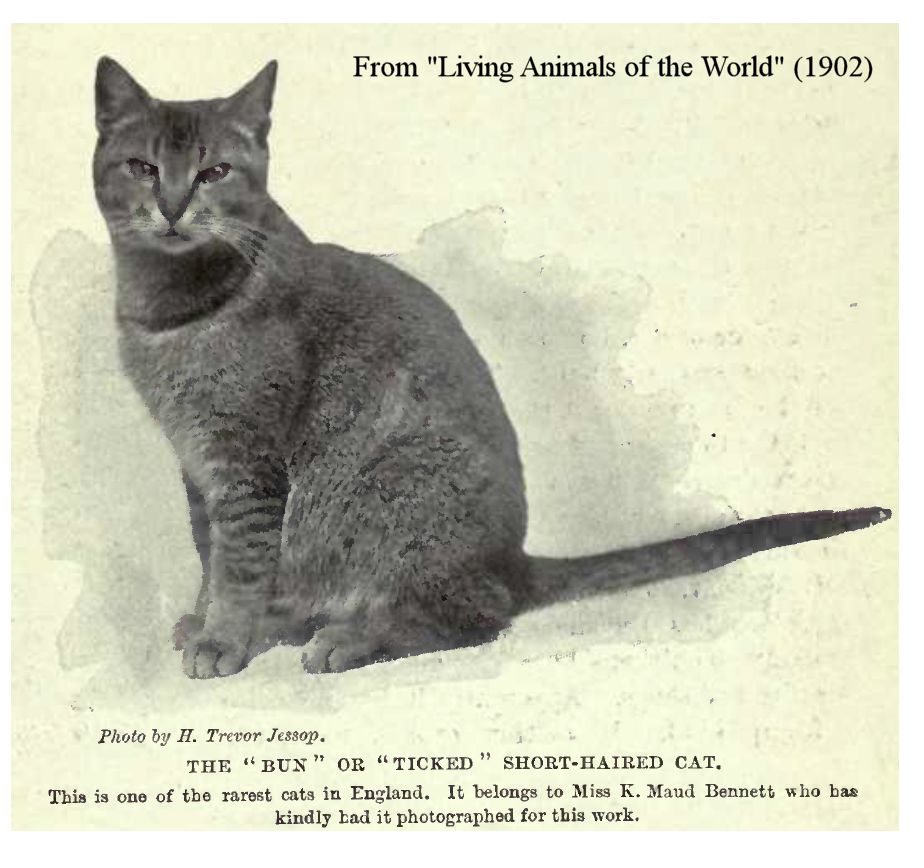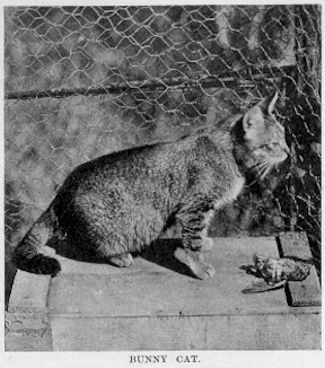
LOST BREED - BUNNY CAT (BRITISH TICK)
Though often confused nowadays with the Abyssinian, the Bunny Cat was once considered a distinct British variety. These ticked cats of early British Shorthair conformation were used in developing the modern Abyssinian. They also produced longhaired variants.
The Abyssinian had been listed as a separate breed in 1882, but in 1889, Harrison Weir ("Our Cats and All About Them") insisted that it was not a breed at all and Louis Wain agreed with him. Both of those notable cat judges considered that "very passable Abyssinian-type kittens are born from time to time as the result of 'chance matings' between very ordinary tabbies." Weir found the native British Ticks to be scarcely distinguished from the imported Abyssinian and some of the early Abyssinian champions were very evidently Ticked British Shorthairs. The first mention of Silver Abyssinians also came from Weir in 1882. He referred to them as a new variety.
Ticked cats were exhibited under a variety of names including Algerian, Hare cat or Bunny Cat. The Bunny Cat was distinct from the Abyssinian and Louis Wain described them as very big cats, both shorthaired and longhaired, that were born black and later lightened to an unbarred agouti coat. Around the 1900s, the Abyssinian was also known as the “British Tick” and had heavily barred legs and tail from being extensively crossed with British Shorthairs including those Bunny Cats. Although classed as "foreign cats" they were far removed from modern Abyssinian cats. Longhaired ticked kittens were being born, but these “sports” would not be recognised in their own right until much later.

Louis Wain, editor of "Our Cats" had a theory on the origin of the Bunny Cats. Hewrote in December 1903 "The Abyssinians, so called, seen in our shows of late years are not the Abyssinians which were exhibited occasionally as a rarity some 15 years ago [1888]. Those cats were a light brown, with just a suspicion of tick on the body, but not one that I have ever seen was free of tabby markings on the legs, head and the ring round the neck. To call the modern ticks Abyssinians is a misnomer. The tick is the ground basis of most tabbies and the pure tick is a conglomerate of Argentine, Chilean, African and in some cases Eastern Cats. I have myself traced the origin of the bunny cats and find them to be of Chilean parentage. They were first introduced to show knowledge by Miss K.M. Bennett, who gave me two kittens, one of which I gave to Mr. Sam Woodiwiss [a noted breeder] who, however, did nothing with it. I have at present four of them, sire and dam, and two eight months old kittens. These have never been shown and I hope to keep them until I can give them to someone who will perpetuate the breed properly and show them [this never happened]. The toms are great cats, far bigger than any cat I have seen at shows for ten years past. The queens are smaller and very highly strung. The tails of all of them are partly ringed and at the stump are as broad as their backs. They are tabby-marked on legs and heads and ringed round the neck. When born, they are nearly black and the first year they are shot with faint thin mackerel markings under the tick marking. The succeeding years the mackerel marking disappears and comes back with age a bit. [...] The fur is bluish near the skin, then half an inch fawn-coloured; following that is a splash of black then the [yellow] tick, and finally tipped with black like a porcupine quill; but please do not call them Abyssinians."
Wain also urged that classes be thrown open to "All ticks, including all English and foreign varieties and colours [and not] levelled down to a cat which is not an easy breeding one. […] The 'bunnies' [British Ticks] throw both long- and short-haired kittens and many are born dead or killed by the mother; hence the strength of the breed; the ailing kittens are killed off."
Listed in Vol 1-2 of the NCC Register, in 1899, was an Abyssinian female called Alice, parentage unknown, owned by Mrs G. [Alice] Pitkin. This cat is listed as the dam of Hamsham, a male Abyssinian born July 1899, sired by Mrs G. Pitkin’s Jumbo. Mrs. Pitkin’s Abyssinians were described by H.C. Brooke as “fair,” being too dark in colour and too much like British Ticks in type.

According to “Cat Gossip” on 23 December, 1927: “There was a cat in the Household Classes at Exmouth which much interested us, and we would like to know how it was bred. It was superbly ticked — better than any Abyssinian of to-day that we know — but strong and British in type; too much barred, and dark in colour; under-colour rather dull, but wonderful for even ticking; a very handsome cat. We incline to think it was one of those “British Bunny Cats,” of which Mr. Louis Wain used to be so fond some thirty years ago; we remember he obtained one for us at a time when the true Abyssinian was almost extinct. It is remarkable how these cats crop up from time to time. A few years back we noticed one in the possession of the caretaker of a hall in Camden Town, where Mouse Shows are often held. There is a fair kitten near here, which occurred in an ordinary litter bred by a Taunton draper’s cat. These cats, as far as we’ve observed, are usually well ticked, but dark, and barred on legs and tail; their type is always what we call “British.” The desirable rufous or brown colour of the Abyssinian — which breed we have always considered was greatly injured by the introduction of the so-called “Silver Abyssinians” — never seem to occur in these British Bunny cats. Some twenty-five years ago or so, when the Cat Club set out to govern, we remember they deleted the “Abyssinian” from their list of breeds, and substituted “Ticks” — a policy which, had it been continued, would probably have destroyed the real Abyssinian Cat, which, according to Dr. Gordon Stables, was introduced after the Abyssinian War.”
As the Abyssinian became more popular, the British Ticks vanished from the show bench. Recently, the British Tick achieved preliminary recognition and recreates the shorthaired form of the Bunny Cat.